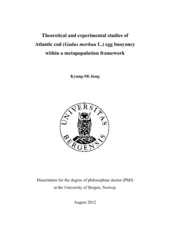| dc.contributor.author | Jung, Kyung-Mi | eng |
| dc.date.accessioned | 2012-12-06T13:08:06Z | |
| dc.date.available | 2012-12-06T13:08:06Z | |
| dc.date.issued | 2012-11-02 | eng |
| dc.identifier.isbn | 978-82-308-2140-4 (print version) | en_US |
| dc.identifier.uri | https://hdl.handle.net/1956/6216 | |
| dc.description.abstract | Marine fishes are subdivided into genetically separated units at various geographical scales. The mechanisms contributing to distinct populations may include year-round site fidelity or natal homing of juvenile and adult stages. Restricted dispersal of pelagic eggs and larvae, associated with ocean environmental conditions, can also enhance distinction between populations. In Norwegian waters, Norwegian coastal cod (NCC) and Northeast Arctic cod (NEAC) are managed as separate units, but increasing evidence demonstrates that the NCC may be structured into local populations on a surprisingly small scale, and that each single fjord population should be preserved for genetic diversity and population persistence. Until now, few studies have been done on ecological and physiological differences among local populations. This thesis was motivated by gaining increased understanding of how retention mechanisms of early life stages along the coast and fjord areas of Norway might contribute to the diversity in coastal cod population structure. A key factor here is believed to be egg buoyancy, i.e. the ability of the eggs to float naturally in seawater. Therefore, this thesis addresses how basic physical, chemical and biological properties influence egg buoyancy to ultimately understand population structuring of Atlantic cod. Specifically it is studied whether or not the phenotypes of egg specific gravity (ρegg), which is a key biological factor determining egg vertical distribution, are different among local populations. Regarding basic knowledge of egg buoyancy, it is examined what are physiological and physical determinants of ρegg, i.e., in light of the important roles of egg osmoregulatory capacity influencing ooplasm specific gravity and the chorion (eggshell) thickness and specific gravity, respectively. The data of ρegg are applied to model egg dispersal during the spawning season in Northern Norway. The modelling results are discussed in the context of metapopulation structure (defined here as a set of semi-independent local populations within a larger area, where typically migration from one local population to another is possible). The eggs used in this thesis were naturally spawned from broodfish and incubated under optimal condition in flow-through aquaria until hatching. In general terms, fertilized eggs showed a slight rise in ρegg until gastrulation (~4 days old) and then a gradual decline in ρegg was apparent until full development of main organs (~10 days old), but ρegg suddenly increased just before hatching (~13 days old). This temporal trend during development seems to be typical for pelagic marine fish eggs. The long-lasting decline of ρegg was attributable to the changes in yolk volume. The initial value of ρegg before spawning was largely determined by the volume fraction of chorion in an egg. When the eggs reduced the specific gravity at later stages, adenylate nucleotides (ATP and ADP) significantly increased. The indicated higher content of energy source might reflect an improved ability for energy-demanding osmoregulation. There was no seasonal trend in ρegg within females, but considerable variation in ρegg was observed among females. Nevertheless, no significant difference was noted in ρegg among local populations. The mean ρegg of the NEAC was similar to that of the NCC, indicating that eggs from the two stocks should have similar vertical distribution under the same environmental conditions. The use of egg dispersal models led to the conclusion that the degree of egg retention is high in fjords, intermediate in coastal areas, and zero in offshore areas. Demographic exchange by egg dispersal could be low not only between fjords and coastal areas but also among neighbouring fjords. With the evidence of resident behaviour in NCC populations, each fjord population may evolve as a discrete population in a metapopulation context. | en_US |
| dc.language.iso | eng | eng |
| dc.publisher | The University of Bergen | en_US |
| dc.relation.haspart | Paper I: Jung, K.-M., Folkvord, A., Kjesbu, O.S., Sundby, S. Physiological determinants of egg specific gravity of Atlantic cod (Gadus morhua L.). Manuscript. Full-text not available in BORA. | en_US |
| dc.relation.haspart | Paper II: Jung, K.-M., Svardal, A.M., Eide, T., Thorsen, A., Kjesbu, O.S. 2012. Seasonal trends in adenylate nucleotide content in eggs of recruit and repeat spawning Atlantic cod (Gadus morhua L.) and implications for egg quality and buoyancy. Journal of Sea Research, 73: 63- 73. Full-text not available in BORA. The published version is available at: <a href="http://dx.doi.org/10.1016/j.seares.2012.06.007" target ="blank"> http://dx.doi.org/10.1016/j.seares.2012.06.007</a> | en_US |
| dc.relation.haspart | Paper III: Jung, K.-M., Folkvord, A., Kjesbu, O.S., Agnalt, A.L., Thorsen, A., Sundby, S. 2012. Egg buoyancy variability in local populations of Atlantic cod (Gadus morhua L.). Marine Biology, 159: 1969-1980. The published version is available at: <a href="http://hdl.handle.net/1956/6217" target="blank"> http://hdl.handle.net/1956/6217</a> | en_US |
| dc.relation.haspart | Paper IV:Myksvoll, M.S., Jung, K.-M., Albretsen, J., Sundby, S. Modeling dispersal of eggs and quantifying connectivity among Norwegian coastal cod subpopulations. Manuscript. Full-text not available in BORA | en_US |
| dc.title | Theoretical and experimental studies of Atlantic cod (Gadus morhua L.) egg buoyancy within a metapopulation framework | en_US |
| dc.type | Doctoral thesis | |
| dc.rights.holder | Copyright the author. All rights reserved | en_US |
